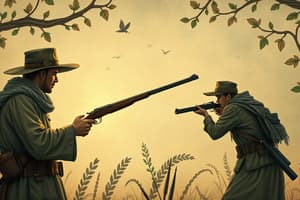Podcast
Questions and Answers
What does 'Limiting Out' refer to?
What does 'Limiting Out' refer to?
- Hunting in a restricted area
- Taking as much game as allowed by law (correct)
- Not hunting during the season
- Taking fewer animals than allowed
What is meant by 'Arrangement' in hunting context?
What is meant by 'Arrangement' in hunting context?
Food, cover, water, and space available to each animal.
What is 'Carrying Capacity'?
What is 'Carrying Capacity'?
The number of wildlife each habitat can support throughout the year.
Define 'Conservation'.
Define 'Conservation'.
What are 'Endangered or Protected Species'?
What are 'Endangered or Protected Species'?
What is a 'Habitat'?
What is a 'Habitat'?
What does 'Starvation' mean?
What does 'Starvation' mean?
What is 'Action' in the context of firearms?
What is 'Action' in the context of firearms?
Define 'Caliber'.
Define 'Caliber'.
What is a 'Cartridge'?
What is a 'Cartridge'?
What does 'Choke' refer to in a shotgun?
What does 'Choke' refer to in a shotgun?
What is 'Gauge'?
What is 'Gauge'?
What is a 'Magazine' in firearms?
What is a 'Magazine' in firearms?
Define 'Rifling'.
Define 'Rifling'.
What is the purpose of a 'Stock' in firearms?
What is the purpose of a 'Stock' in firearms?
Define 'Waterfowl'.
Define 'Waterfowl'.
What does 'Endangered' mean?
What does 'Endangered' mean?
What does it mean to 'Migrate'?
What does it mean to 'Migrate'?
What is 'Hypothermia'?
What is 'Hypothermia'?
What is a 'Personal Flotation Device (PFD)'?
What is a 'Personal Flotation Device (PFD)'?
Define 'Full Body Harness'.
Define 'Full Body Harness'.
What is the 'Code of Ethics' in hunting?
What is the 'Code of Ethics' in hunting?
What is the First Code of Ethics?
What is the First Code of Ethics?
What is the Second Code of Ethics?
What is the Second Code of Ethics?
What is the Third Code of Ethics?
What is the Third Code of Ethics?
What is the Fourth Code of Ethics?
What is the Fourth Code of Ethics?
What is the Fifth Code of Ethics?
What is the Fifth Code of Ethics?
What is the Sixth Code of Ethics?
What is the Sixth Code of Ethics?
What is the Pittman-Robertson Act?
What is the Pittman-Robertson Act?
What does the Dingell-Johnson Act do?
What does the Dingell-Johnson Act do?
What are the 5 Rifle Actions?
What are the 5 Rifle Actions?
True or false: Safeties are foolproof.
True or false: Safeties are foolproof.
What are the Rifle Shooting Positions?
What are the Rifle Shooting Positions?
________ a shotgun.
________ a shotgun.
________ a rifle.
________ a rifle.
True or false: The basic parts of a rifle or shotgun are the barrel, action, and safety.
True or false: The basic parts of a rifle or shotgun are the barrel, action, and safety.
True or false: The four parts of a tilde cartridge are the case, bullet, primer, and powder.
True or false: The four parts of a tilde cartridge are the case, bullet, primer, and powder.
Flashcards are hidden until you start studying
Study Notes
Game and Wildlife Management Terms
- Limiting Out: Refers to taking the maximum legal amount of game or fish allowed.
- Arrangement: The combination of food, cover, water, and space necessary for wildlife.
- Carrying Capacity: The maximum number of wildlife a habitat can sustain throughout the year.
- Conservation: The responsible and sustainable use of natural resources.
- Endangered or Protected Species: Species that receive legal protection to prevent extinction.
Firearm Basics
- Action: The mechanism in a firearm responsible for loading, firing, and ejecting cartridges; includes five types: bolt, lever, pump, semi-automatic, and break.
- Caliber: Measurement of a rifle's bore, typically the distance between the grooves inside the barrel.
- Cartridge: A completed round of ammunition including the primer, powder, casing, and projectile; can be rim-fire or center-fire.
- Choke: A constriction at the muzzle of a shotgun that influences the spread of the shot.
- Gauge: Indicates the bore size of a gun, based on the number of lead balls that fit in the bore to equal one pound.
Firearm Components
- Magazine: The part of a firearm that stores ammunition until it's needed for firing.
- Rifling: The helical grooves inside a gun barrel that allow the bullet to spin and stabilize during flight.
- Stock: The frame of a firearm that supports the barrel and action; aids in aiming and absorbs recoil.
Wildlife Concepts
- Waterfowl: Refers to aquatic birds such as ducks and geese that are commonly hunted.
- Endangered: A status indicating that a species is nearing extinction.
- Migrate: The seasonal movement of animals from one region to another, typically for breeding or climate reasons.
- Hypothermia: A dangerous condition where the body loses heat faster than it can generate it.
Safety Equipment
- Personal Flotation Device (PFD): Safety gear worn to prevent drowning in water activities, commonly known as a life jacket.
- Full-body Harness: Safety equipment that secures a person while hunting, designed to keep the individual upright in case of a fall.
Ethics and Codes of Conduct
- Code of Ethics: A set of principles promoting respect and safety in hunting; comprises six rules.
- First Code: Always seek permission before accessing private land.
- Second Code: Follow and promote safe firearm handling practices.
- Third Code: Adhere to laws and regulations regarding hunting and firearms.
- Fourth Code: Develop strong shooting skills for humane kills.
- Fifth Code: Support conservation initiatives to foster future hunting opportunities.
- Sixth Code: Mentor others to cultivate responsible hunting practices.
Legislation and Programs
- Pittman-Robertson Act: A law aimed at restoring and managing wildlife populations through funding from hunting-related activities.
- Dingell-Johnson Act: Legislation focused on fish restoration and management efforts.
Shooting Techniques and Knowledge
- Rifle Actions: Types include pump, bolt, break, semi-automatic, and lever.
- Rifle Shooting Positions: Common stances include kneeling, standing, sitting, and prone.
- Shotgun Aim: Points to the technique of aiming with a shotgun, crucial for successful shooting.
- Rifle Aim: Refers to the process of accurately targeting with a rifle for effective shooting.
True/False Assessments
- False: Safeties are not foolproof, highlighting the need for caution.
- True: Understanding that a cartridge comprises four crucial parts: case, bullet, primer, and powder.
Studying That Suits You
Use AI to generate personalized quizzes and flashcards to suit your learning preferences.




